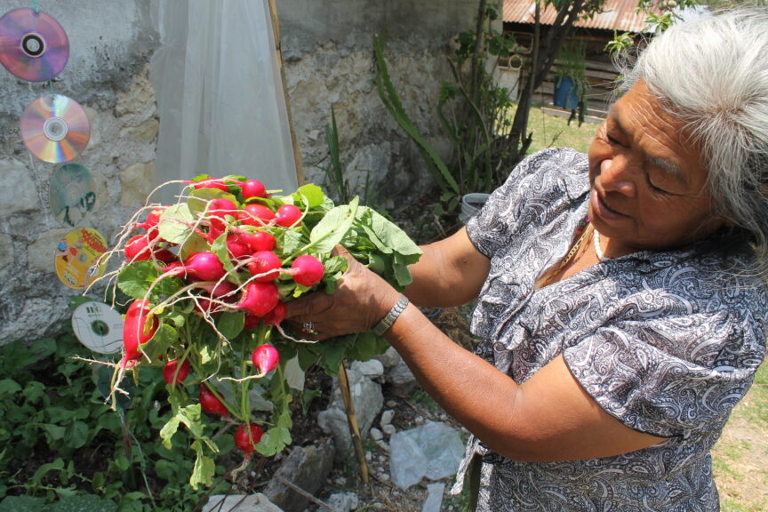Alejandra Guzman Luna writes about agroecology and community feminism, drawing from her experience working in the Oaxacan Mixteca, Mexico. The notion of community feminism is a vital way to advance an agroecology that effectively nourishes territories in an equitable manner. This blog is a part of a series of blogs on feminism and agroecology (see here for another) in our Agroecology in Motion column.
[Spanish version; French version]
In 2017, at the end of the dry season, I arrived in the community of San Miguel in the Oaxacan Mixteca. My goal was to study the agroecological practices there. Doña Maria, an initially serious and hermetic woman, after warning me that “in this house sometimes we only eat tortillas with salt,” agreed to host me for a month. Her home had two spaces. A brick and cement room, in another space was her wooden kitchen with a dirt floor and a wood stove. To get to the center of her community, where the nearest grocery store was located, we had to walk more than an hour through fields of crops and the occasional tree of what, a few decades ago, was forest. After a few days of my stay there, the food I had brought to share ran out. So, we effectively started eating tortillas with salt. Then, Doña María took me to a place where we walked for a couple of hours to gather firewood, some cactus and wild herbs to accompany the tortillas. Against that backdrop, the idea of agroecology and food sovereignty shone like a promise for families like Doña María’s.
Doña María in her kitchen making tortillas, Oaxaca, Mexico. By Alejandra Guzmán Luna, 2017.
After a few weeks, I approached Doña María and other women who, like most of the households in that town, had migrated to the city or to the United States to work. There I understood that food insecurity was the least of their problems. The patriarchal violence suffered by these women, even from a distance, is brutal. I even heard that the mother of one of them had died as a result of her husband’s physical violence. In this context, what could be the relevance of a discussion on native seeds or agrochemicals? I felt that agroecology and I were out of place.
Traditional Mixtec preparation for milpa seeding, Oaxaca, Mexico. By Alejandra Guzmán Luna, 2017.
However, towards the end of my stay there, I had a conversation with Doña María in which she told me how comfortable her life was now with her husband away:
“Nobody bothers me anymore. I go to visit my friends, I take care of my greenhouse and my cornfield as I wish. What comes out of it is what my daughter and I eat. Doña María’s milpa is completely traditional (i.e., agroecological) and therefore requires a lot of labor, so I immediately asked her if she and her daughter could do the work alone. Her answer was simple but powerful: “No, not alone. But with the tequios we can”.
Tequios are a form of collective work in which people who are part of a community have a moral commitment to come to a work request. In exchange, the family that made the invitation offers food, soft drinks and mezcal. In addition, the hosts have the obligation to respond to the attendees’ request for tequio. Tequio (or minga in South America) is deeply rooted in most of the native peoples of Latin America. This potential to reproduce collective life is precisely the aspiration of community feminisms, but it is also the aspiration of agroecology! In the case of San Miguel, there is still a lot of work to be done to overcome patriarchal violence, desertification and chronic hunger. However, this experience shows us that the way to overcome them is communitarian and agroecological.
Mother’s Day festival in the community of San Miguel, Oaxaca, Mexico. By Alejandra Guzmán Luna, 2017.
What distinguishes agroecology from other environmentally friendly forms of agriculture is the recognition of power dynamics and its intentionality to overcome them; the first of these dynamics is within the household (Bezner Kerr, 2020). In this sense, agroecology and community feminism share the incorporation of multiple oppressions interacting in the territory.
Community feminism was created by Xinka, Mayan and Aymara women in Guatemala and Bolivia based on the fact that the same forces that oppress women also oppress nature. To conceptualize this, within community feminism, two territories are recognized in a historical structure of colonial and patriarchal exploitation and violence. Lorena Cabnal (2010), one of the main representatives of this feminism, explains that the territory-body is connected to the corporeality of women, and that it is controlled in their thoughts, decisions and actions. On the other hand, the territory-land is the concrete geographic space that, to put it in Western terms, harbors natural resources that can be exploited and also controlled.
For community feminists, there can be no liberation of one territory without the other since both are part of a community. In this sense, they conceive of a community as
“a being in itself, with its own identity. Women, men, land, territory, animals, vegetables. Vertically, above – sky, air space and all its living beings -, below – subway, animal, vegetable and mineral life. And horizontally, here – where we move all human, animal and vegetable living beings – the extension of the earth (…). The community nourishes those who walk with the community, and the community, in turn, is nourished by the work” (Assemblies of Community Feminism, 2014).
Mixtec grandmother and granddaughter in San Miguel, Oaxaca, Mexico. By Alejandra Guzmán Luna, 2017.
From this perception of community, agroecology also aspires to the construction of reciprocities between territory-body-land. In other words, agroecology seeks the fair and equitable integration of the elements that make up a system (or community): land, water, climate, microorganisms, pollinators, agrobiodiversity, women, men, youth and children who contribute to food production. And, transcending the production, and incorporating food distribution, agroecology aspires to build the foundations for a global food system that effectively nourishes all territories in an equitable manner.









